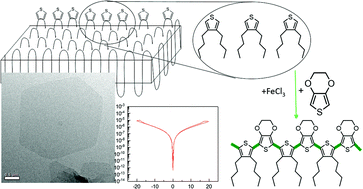Polymer Defect Engineering – Conductive 2D Organic Platelets from Precise Thiophene-Doped Polyethylene
Authors: Max Planck Institute for Polymer Research, Germany; University of Twente, Netherlands
Abstract
We developed a simple way to create 2D conductive nanostructures with dielectric cores and conductive surfaces based on polyethylene with in-chain thiophene groups. Generally, thiophene-based polymers show great conductive properties, but exhibit a poor processability. Here, we use the crystallization of a polyethylene chain with precisely distributed thiophene groups as the platform for a self-organization of a lamellar structure. During crystallization, thiophene groups are expelled to the crystal surface. Subsequent copolymerization with 3,4-ethylenedioxythiophene (EDOT) molecules finally yields 2D platelets with a conductive surface. The electric properties of the surface are demonstrated by conductivity measurements. Given the molecular structure of the polymer, it can be assumed that the conductive layer consists of only one monoatomic layer of polymerized thiophene. We thus show a new way to create an ultra-thin, conductive surface on a polymer surface in just a few steps. Hence, the method presented here opens up a wide range of possibilities to produce complex, nanoscale electronic structures for microelectronic applications.
Mass spectrum analysis was obtained by ASAP/CMS using the Advion Interchim Scientific® ASAP® Atmospheric Solids Analysis Probe and expression® Compact Mass Spectrometer (CMS)

